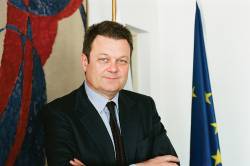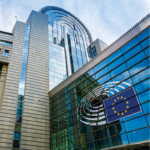 Carlo des Dorides, GSA Executive Director
Carlo des Dorides, GSA Executive DirectorLast October, the European GNSS Agency (GSA) Administrative Board reelected Carlo des Dorides as executive director of the GSA, giving him a second — and final — four-year term in charge of this key agency responsible for supporting the effective operation, maintenance, and security of Europe’s satellite navigation systems. We met with him recently at the GSA office in Prague to learn how he plans to see out his mandate.
Last October, the European GNSS Agency (GSA) Administrative Board reelected Carlo des Dorides as executive director of the GSA, giving him a second — and final — four-year term in charge of this key agency responsible for supporting the effective operation, maintenance, and security of Europe’s satellite navigation systems. We met with him recently at the GSA office in Prague to learn how he plans to see out his mandate.
“The GSA Board’s unanimous vote to keep me as the agency’s Director was really a recognition of the work of our entire staff,” says des Dorides. That staff, now spread across Europe, currently numbers about 140, from Prague to Toulouse and from Swanwick to Madrid.
The agency’s tasks include encouraging the exploitation of Galileo and the European Geostationary Navigation Overlay Service (EGNOS), market development, security accreditation and monitoring, project control, communication, procurement, and financing. It’s a lot for one man’s plate, but with his final term still mostly in front of him, des Dorides says, “I feel free; I’m here and I have the strong support of the EU institutions. I am encouraged.”
From Here to 2020
Des Dorides’ vision for the coming years, he says, starts with delivering what’s already on the table.
“EGNOS is well under control,” he says. “We have stable operation and service provision.” But there will be no easy life for Europe’s satellite-based augmentation system. “EGNOS is coming to the end of a cycle of relative calm equilibrium,” but new, major technical developments are on the way, with tenders to be announced in the coming months.
Planned upgrades include the release of EGNOS v2.4.2 software, bringing new enhancements at service level, including the extension of aircraft approach operations with vertical guidance (APV-I) coverage to the northeast, east, and southeast of Europe, and the setting up of new regional integrity monitoring stations (RIMS) to boost coverage in places like the Canary Islands. The GEO satellite constellation will also undergo further modernization.
“We want to apply EGNOS to more than just civil aviation,” says des Dorides. “We now have close to 200 airports with EGNOS-enabled landing approaches, and we will double this number by 2018-2019. But we want to export EGNOS outside of civil aviation, to maritime transport and the rail industry, where we have seen very good results.”
For Galileo, he says, initial services are still on course for October 2016. “Six to eight months later, in 2017, we will have a new operator/service provider. This is a major change; today the operator acts on a ‘best-effort’ basis. In the future, the operator will be assessed on a ‘service-level’ basis. The new operator will ensure stable continuity of Galileo operations, at full speed, with maturity in the following years. We want to have stable operation by 2020.”
Securing the PRS
Also coming soon is the secured Galileo Public Regulated Service (PRS), one of the important features of Galileo, with access limited to authorized governmental bodies.
“In the past two to three years, we have been investing in the PRS user segment,” des Dorides says. “We have right now three important ongoing projects for establishing the EU industrial basis to build the PRS receiver system.” (See sidebar, “Current EU-funded PRS–Related Research Projects,” at the end of this article.)
Des Dorides says the PRS should be up, running, and mature by 2020.
“The PRS is very important,” des Dorides adds, “providing 50 percent of the answer to the question of why we have Galileo. But we need a proper receiver segment in Europe. If not, the PRS doesn’t make sense.”
As far as the discussions regarding U.S. access to the PRS, des Dorides says that’s not a part of his mandate. However, he notes that “the Dutch EU [European Union] Presidency has made it a priority to see negotiations on this question move forward by the European Council and Member States before the close of its tenure, which ends in June 2016.”
Those official negotiations will involve the European Commission and U.S. Department of State.
Change of Scene
The EU policy of physically moving certain of its agencies away from Brussels to far-flung places like Prague has been an interesting and, some believe, fruitful experiment, stimulating awareness, interest and engagement in “all that is EU” among local business communities, academia, and political establishments.
On the flipside, the process has also allowed some of the Union’s own best and brightest, like those working for the GSA, to get a feel for life away from the Brussels beltway.
In 2012, that meant uprooting GSA staff and their families, asking them to move to a foreign, albeit still thoroughly European, country, and, significantly, getting them to accept a new cost-of-living index (ouch!). Everyone did their best, and some difficult choices had to be made.
Now, nearly four years on, with senior staff mostly used to their new lives, and with newer staff coming on board who never knew the GSA in Brussels, the big move is starting to feel like water under the bridge. For des Dorides at least, there have been compensations, including a really cool office overlooking the Vltava River in downtown Prague.
The Czechs rolled out the red carpet when their first bona fide EU agency came to town, offering up the monumental, 1970s communist-era, former Czechoslovakian Ministry of Finance building as the GSA’s new HQ.
The striking tapestries that came with the place and now hang in des Dorides’ office are by the famous Czech artist František Kupka.
A soaring atrium greets one upon entering the building, and a large and very impressive conference room sits off to one side, newly fitted with the latest high-tech sound and communications gadgetry, spectacular lighting, and even a swath of twinkling stars to put you in the mood.
Be all that as it may, the GSA these days is less about show and more about action. It’s got money to spend and plenty to spend it on. “Our budget is about €500 million [US$566 million],” says des Dorides. About 95 percent of that is delegated, i.e., it’s money the GSA is told how and when to spend by the European Commission (EC) in Brussels.
“The GSA is like nothing else in the EU universe,’ des Dorides says. “The European Commission has a double role for us — it is our customer, it pays us to do a job, but it also sits on our administrative board; so, it is a stakeholder as well.”
It’s a two-way exchange: des Dorides spends about one day a week in Brussels while the GSA gets lots of visitors from the commission. “Coordination with the EC is very strong,” he says.
GSA and ESA Align
The GSA’s other key and long-standing partner is of course the European Space Agency (ESA), based in Paris and with important facilities in Toulouse, France, and Noordwijk, Netherlands, and elsewhere.
“In reality,” des Dorides says, the formal relationship between ESA and the GSA only came into force last year, when we signed the EGNOS delegation agreement.”
Although the GSA and ESA had been working together for much longer, that previous collaboration was channeled through ESA’s cooperation with the EC and other EU bodies. In any case, the official GSA/ESA relationship is now officially under way as far as EGNOS is concerned. The same will be true for Galileo, if, as expected, the ESA Council ratifies a similar agreement with the GSA for that program next December.
It’s all happening at the right moment, says des Dorides. With Jan Woerner taking over as ESA director general and with former EC satnav manager Paul Verhoef now in as ESA’s director of the Galileo program and navigation-related activities, des Dorides says he sees a “new cycle” beginning, with a group of cohorts that “appreciate each other’s constraints.”
“ESA has a contract with the GSA,” des Dorides explains, “to do the Galileo hardware, to build the infrastructure. We are now negotiating with ESA about the flow of responsibilities and how to transfer funds.”
This is, in fact, a reversal of sorts for ESA, which has generally been the body telling its own contractors what to do.
“Up to now there has been rigidity at ESA,” says des Dorides. “But with Paul, who I worked with when he was at the Commission, and with Jan Woerner, who comes from Germany’s space agency, DLR, we see a better understanding.”
Des Dorides says ESA and the GSA are working well together on the EGNOS project. Part of the solution, he says, has been simply being together, physically. “Seeing each other and interacting is important,” he says. Which is one reason the GSA has installed a small team to work alongside ESA staff at the Toulouse Space Center, doing EGNOS operations and service provision.
A similar arrangement could be in the works for Galileo, with a small GSA team possibly to be sent to ESA’s ESTEC facility in Noordwijk.
Meanwhile, a major investment will be made in a new, independent Galileo Reference Center.
“This will be the latest GSA facility,” des Dorides says, “which will be used for independent assessment of Galileo performance, checking all performance indicators. It is being built right now in Noordwijk, right next door to the ESTEC facility.”
Des Dorides says the EU and ESA could still benefit from better coordination of their GNSS-related efforts. With limited resources, the idea of further integrating GSA and ESA operations makes sense.
Funding for Downstream
The question of resources, and funding in particular, is, as ever, an ongoing concern. Someone once said, “No bucks, no Buck Rogers.” Well, “No bucks (or euros), no Galileo” either. In the EU, that comes down to the EU Parliament, which ultimately approves budgets and hands out the cash.
And we all remember that one of the key arguments for building Galileo in the first place was that it would stimulate new downstream business. New European downstream business, that is.
Recently, in a special “space” issue of the EU Parliament’s own glossy magazine, The Parliament, Axelle Pomies of Galileo Services, an organization that represents downstream industry, pointed out that in the 2014–2020 time period, the EU will have invested around €8 billion in European GNSS infrastructure, but only around €200 million in the development of Galileo-capable products, value-added applications, and services; that’s a ratio of 40 to 1.
As Pomies writes, “The EU’s effort to gain its independence as regards GNSS by building its own infrastructure will be pointless if it is dependent on foreign applications, receivers, and devices.”
Des Dorides says Pomies has a point. After noting that her organization, Galileo Services, naturally and rightfully represents the interests of the private sector, des Dorides responds, “From the previous financial perspective to the current one, we have doubled the available downstream funding, from €75 to €150 million, plus another €100 million for ‘fundamental elements’, meaning receiver technologies.”
“Is 250 million enough?” he asks, “Maybe not, but it’s more than we’ve ever had in the past.” Des Dorides also points out that ESA has it’s own apps budget, namely the Integrated Application Program, and some further EU funding for “GNSS transversal projects,” being coordinated by the EC’s transport directorate-general (DG MOVE).
And then there are the EU member states with their own R&D programs. Here, des Dorides says, the important thing is to avoid overlap, and better coordination could improve things.
All that being said, with U.S., Russian, and even Chinese GNSS systems already in place or further along in development, Europe could do more to boost the Galileo brand.
Role for EU Parliament
Perhaps the fundamental question is simply why isn’t the EU laying out the dough for downstream development, when everyone knows that’s where the return is.
Des Dorides thinks, where the Parliament in concerned, it might be a question of culture. He says the GSA has been making directed efforts to cultivate its relations with the Parliament. “We need to bridge with them,” he says, “and that is starting. We have GSA people doing that job, taking steps to close the gap with the Parliament, and in return we’re now getting more questions and some new ideas.”
To be fair, the onus for getting the funding right cannot be placed solely on the Parliament. Yes, they approve budgets, but it is still the Commission, with the help of the wider European space community, that writes the budgets, that requests the funding, and upon whom the burden falls of explaining, defending, and fighting for that support. All efforts by the space community to win more hearts and minds in the Parliament are a part of that process.
Des Dorides reminds us that with EU institutions everything takes a long time. Meanwhile, the GSA has the budget that it has, and the question then becomes how to direct the available funding to where it really needs to go.
Des Dorides says the European Commission’s current research framework program, “Horizon 2020,” is good at financing research and innovation, but not necessarily work that is very close to the business end.
“Businesses don’t use H2020 because it takes too long,” he says, “from the call launch to the award process and final contracts, it can take 18 months before a project starts. This is just too long in the private sector.”
For that reason, he says, the EU may need to think about a new kind of funding instrument, something more reactive, something that could, for example, take the place of Europe’s missing venture capital.
“Here in Europe,” he says, “we don’t have a venture capital culture — but maybe can we simulate a venture capital approach from the public sector.”
The focus, des Dorides says, needs to be on innovative GNSS-related business ideas, with all funding options on the table, and all potential players in the discussion, including the European Investment Bank.
“There are people who know more about that than I do, but we probably need to tailor a better product for GNSS investment,” he says.
More to Do?
Looking beyond the GSA’s patch of ground, but not so very far after all, we peek across the fence to consider the other flagship EU space program, “Copernicus,” i.e., the program formerly know as GMES, the Global Monitoring for Environment and Security program, and what do we see? A huge and elaborate EU space infrastructure program that seems to have paid little or no attention to its own downstream market potential. Sound familiar?
One EU insider says, “Companies in the U.S. are making big money by providing added-value services based on EU-generated Earth observation data!” Shouldn’t someone be looking at this?
The potential synergies between positioning and Earth observation technologies will not have escaped the attention of anyone reading this article. More and more, users of either of these will want and need to both resources to answer the questions, “where am I” and “what’s around me.”
But, des Dorides accepts, the two programs, Galileo and Copernicus, are separate entities today, with different histories: “Copernicus started as a public sector–oriented program, with little interest in the private sector. With Galileo, we have been more in touch with companies, with the private sector, from the beginning.”
A marriage made in heaven?
“Rationalization of the two programs will happen,” says des Dorides.
Does that mean a convergence, an interconnecting of the two? The answer is we don’t know yet, but we know people are thinking about it.
Today there is no EU agency focused on Earth observation as GSA is on GNSS or to look after its market development.
Big on Market Development
Indeed, the GSA puts a lot of effort indeed into market development. The agency carries out its own research into GNSS market trends, and then makes the information it gets available in the form of an annual GNSS Market Report, whose publication has become a fixture on the GNSS calendar. The aim is to help European companies understand what’s going on and hopefully get a leg up on the competition.
Saying thanks and “so long” to des Dorides, we wander over to meet his top market person, Gian Gherardo Calini, whose office view rivals that of the Director himself.
Calini knows a lot about GNSS market trends, and he makes it his business to make sure Europe knows about them, too.
So what’s on his mind? He answers, “Geofencing, for the elderly and for your pets; autonomous vehicles, drones, robots for future farming.
“GNSS growth cannot be forecast,” Calini says. “So much is unseen, as yet unimagined. We need to exploit to the max, and so much depends on us. Does the supply create the demand? Or is it the other way around? The truth is somewhere in the middle. We are living in an innovative century, where technologies are driving the market, creating new markets and new demands. What we need today are engineers with a ‘market mind.’ We need Silicon Valley types here in Europe.”
At this point, Calini announces the launch of a new User Technology Report, before the end of this summer, to complement the GSA Market Report.
“What we want to know and what we talk about in this new Report is what are the trends in user technologies, and especially the ones we haven’t been thinking about enough, like Big Data, the Internet of Things, connected cars, ubiquitous positioning, assisted GNSS for emergency services, augmented reality, Google glasses, crowd sourcing for LBS in real time. . . . The list goes on.”
Sitting with us is GSA Market Development Officer Reinhard Blasi, who points out, “Positioning is a key enabler of all this,” and adds, “Galileo will be interoperable with the next generation of GPS; so, these combined dual-frequency systems will enable extremely high accuracy and a high level of confidence for safety-critical applications. The foreseen commercial service will include authentication for the professional market and unheard-of precise point positioning.”
Blasi says users don’t care about which constellation they are using; they are only interested in performance. But should the user know about Galileo? Does the GSA want them to know?
“We don’t necessarily need to advertise Galileo to the mass market user,” Blasi says, “But we think policy makers and receiver manufacturers do need to know.”
Head of Communications Donna Reay confirms that a big mega-campaign aimed at the public is not especially in the works in the run-up to Galileo initial services.
“For now we want to be humble,” says Blasi, “We have learned our communication lessons — not to raise expectations too high. We want to be cautious, but this will be a milestone for industry.
“More satellite launches are upcoming,” he says. “Galileo is finally gaining momentum. The hardware is ready, the software is mostly ready; so, now it is just a question of switching over to ‘OK, we are now using it.’”
SIDEBAR: Current EU-funded PRS–Related Research Projects
Project FRAME – GSA/OP/20/14 – procurement closed
Provision of processes and tools to support GSA activities related to the definition of new PRS use cases, including the conditions of coexistence with traditional PRS use cases.
Project PRISMA – GSA/OP/07/15 – procurement on-going
‘Development of low-end operational PRS receivers including security modules architectures’
Project DISPATCH – GSA/OP/02/15 – procurement on-going
Development of end-to-end prototype capable of testing the security aspects of PRS service provision by innovative PRS server-based technologies to support future applications.





